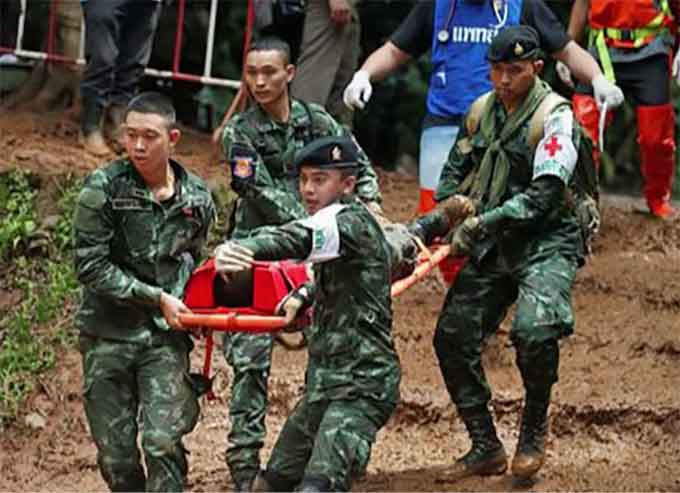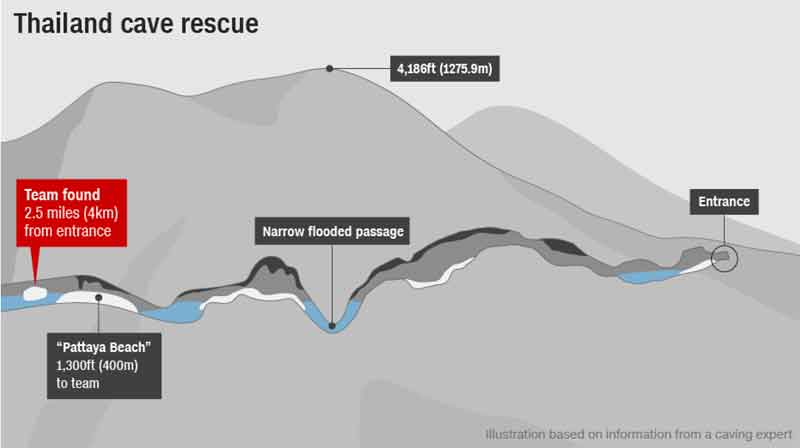
By Steve George, Sheena McKenzie and Dakin Andone, CNN
The operation to rescue the remaining boys and their coach from a flooded cave in northern Thailand was expected to resume Monday morning, but heavy rain threatened to further complicate the mission.
Four of the 12 boys were extracted from the Tham Luang cave network in the Chiang Rai province Sunday evening, before the operation was suspended overnight to allow oxygen tanks to be refilled before rescue teams begin the next phase.
The four boys, who were taken to a Chiang Rai hospital for further medical examination, are said to be in good health, with their condition described by officials as “not that bad.”
(Thai Navy SEAL says 4 members of the soccer team are out of the cave. Ambulances were seen rushing to a nearby hospital. The rescue efforts in Thailand are still suspended while teams restock supplies and prepare to get the rest of the team out of the cave. Courtesy of CNN and YouTube. Posted on July 8, 2018.)
But rescue teams don’t have an abundance of time.
Rain began to fall on Sunday, and more rain is forecast throughout the coming days, which could undo the ongoing efforts to drain the flooded caverns where the other boys remain trapped.
“We have two obstacles: water and time,” said Chiang Rai Gov. Narongsak Osotthanakorn earlier Sunday, as rain began to fall across the site near the cave entrance.
“This is what we have been racing against since day one,” he said.
“We have to do all we can, even though it is hard to fight the force of nature.”
‘A very smooth operation’
Sunday’s mission went quicker than it had in drills over the last several days, according to Osotthanakorn.
Previously, the entire round trip through the cave network was thought to take about 11 hours.
But the first of the four boys emerged from the cave entrance about nine hours after a team of 18 international cave diving experts went in to retrieve them.
(Four schoolboys have been rescued from the flooded cave in northern Thailand. Courtesy of Channel 4 News and YouTube. Posted on Jul 8, 2018.)
The boys wore “full face masks and the rescue divers carried them out through the passage in the cave complex,” Osotthanakorn said in a news conference after the rescue.
“It was a very smooth operation today,” he added.
While the governor would not confirm the identities of the four boys, he said the first one emerged at 5:40 p.m., followed by the second boy 10 minutes later.
Two other boys emerged from the cave at 7:40 p.m. and 7:50 p.m.
Twelve boys — aged between 11 and 16 — and their coach, were discovered by two British divers on July 2, nine days after they abandoned their bicycles and disappeared into the Tham Luang Nang Non cave complex.
Pressure mounting as rain dominates forecasts
Rescuers have a dwindling window of opportunity, with forecasters predicting the return of heavy monsoon rains in the coming days, effectively sealing off the cave until October.
It was the rain that stranded the boys and their coach inside the cave to begin with, after they ventured into the cave network last month.
“The heaviest rain has yet to come,” said CNN meteorologist Allison Chinchar.

Rescue teams have been helped by the fact that the rain stopped for several days, Chinchar said, allowing water to be pumped out of the cave and making it possible for the four boys and specialist rescue teams to make the final leg of the journey on foot.
But that could change in the coming days, Chinchar added. Monday, Tuesday and Wednesday each have an 80% to 90% chance of rain.
“And really when you look at the long-term forecast, it really extends the next seven to 10 days,” she said.
Osotthanakorn told reporters there would be a meeting Sunday evening to plan next steps, and that authorities want to ensure conditions are stable before beginning the next phase of the rescue.
A dangerous journey
Those still inside the cave are perched on a small muddy ledge 4 kilometers (2.5 miles) inside the cave complex, surrounded by floodwater and with a limited supply of oxygen.
For the boys — some of whom can’t swim — the most dangerous part of the journey out of the labyrinth cave system remains the first kilometer, in which they are required to pass through a flooded channel no wider than a person.
During this process, rescuers need to hold the boys’ oxygen tanks in front of them and swim pencil-like through submerged holes.
Having completed this section, the boys are then handed over to separate, specialist rescue teams, who help assist them through the remainder of the cave, much of which they can wade through.

Initially, officials said the strongest boys would be taken out of the cave first.
But Osottanakorn said on Sunday it would be up to boys and a doctor inside the cave with them to determine the order in which they would exit.
That decision would also depend on a medical examination by the doctor.
“I don’t know who will come out first,” the governor added.
Divers have previously described conditions in the cave network as some of the most extreme they have ever faced.
The decision to move the boys using divers has not been taken lightly.
On Friday, a former Thai Navy SEAL died while returning from an operation to deliver oxygen tanks to the cave.
(A former Thai navy diver who joined the operation to rescue 12 boys and their coach from a cave in northern Thailand has died, according to a Thai Navy source. Courtesy of CNN and YouTube. Posted on Jul 5, 2018.)
Finnish volunteer diver Mikko Paasi, a long-term resident of Thailand, said the death of the Thai Navy SEAL had changed the mood on the ground and made real for rescuers just how dangerous the mission had become.
“Definitely, you can feel it that it has an effect, but we’re moving on. Everyone is a professional so we’re trying to put it away and avoid it happening again,” he said, adding: “Everybody is focusing on getting these boys out — keeping them alive or getting them out.”
Families remain vigilant, hopeful
In the hours preceding the rescue, a letter the boys had sent to their families was published on the Thai SEALs’ Facebook page.
The letter shows the boys in good spirits despite their ordeal.
In neat blue handwriting, 11-year-old Chanin Viboonrungruang, the youngest of the group, told his parents not to worry, and said he was looking forward to eating fried chicken.
(The father of one of the 12 Thai boys trapped in a cave with their soccer coach speaks out after Thai navy SEALs helped them communicate with their families through handwritten notes. Courtesy of CNN and YouTube. Posted on July 7, 2018.)
On reading the letter Saturday evening, Chanin’s father, Tanawut Viboonrungruang, said he felt a great sense of relief.
“I had been worried about my son, that he would be exhausted, he would be tired,” he said.
The aunt and grandmother of one of the boys, Prajak Sutham, said earlier in the day they learned the rescue effort was underway via Facebook, and were anxiously awaiting news that Prajak had made it out safely.
“It’s like I’m counting every second,” said Salisa Promjak, the aunt. “I want to see his face. I want to see how he gets out, how they get him out … I am so happy.”
(Four boys of the trapped in the Thailand cave have been rescued. Now the focus shifts to their health, after having spent more than two weeks trapped in the cave. Dr. Robert Glatter, emergency physician at Lenox Hill Hospital in New York, joined CBSN to talk about how health officials will treat the boys who have been rescued, as well as those still trapped inside. Courtesy of CBS News and YouTube. Posted on Jul 8, 2018.)
Asked what she would say when she first sees her grandson, Kiawakham Chantaphoon said, “Grandma loves you the most in the whole world.”
They also wanted to express their gratitude to the rescue teams working to free Prajak and his teammates.
“As a cousin and as a representative of all 13 families, I cannot find words to explain our feelings and how glad and grateful we are,” said Promjak.
“Just the words ‘thank you’ is not enough to explain all the feelings we have for them.”
Rescued boys begin the recovery process
Now that the first of the boys have been taken to a nearby hospital, doctors there will begin evaluating the impact to their long-term health.

One of the primary concerns will be the boys’ exposure to a lack of oxygen, said Dr. Darria Long Gillespie of the University of Tennessee.
“As soon as they get out, that’s what they’ll be checking: their oxygen levels and their breathing.”
Thai officials said Friday that oxygen levels inside the cave plummeted to a dangerous 15% — shy of the US Department of Labor’s Occupational Safety and Health Administration’s “optimal range” of oxygen, which is between 19.5% and 23.5%.
As oxygen drops below the lower threshold of the optimal level, the body begins to undergo changes and may face the serious risk of hypoxia, the condition that causes altitude sickness, according to OSHA.
The boys will also be checked for malnutrition, dehydration and an array of other health effects.
CNN’s Steve George reported from Thailand, Sheena McKenzie reported and wrote from London and Dakin Andone reported and wrote this story from Atlanta. CNN’s Jo Shelley, Kocha Olarn, Sandi Sidhu and journalist Lalinda Siripornmanut contributed to this report.
Original post https://www.cnn.com/2018/07/08/asia/thai-cave-rescue-mission-intl/index.html
(A Short Tribute to the former Thai Navy Seal “Saman Gunan” who died while trying to save the 12 Missing Boys from the Thai Soccer Team. Saman Gunan a Petty Officer 1st Class ran out of oxygen while he was trying to bring more Oxygen Air Tanks back and fort from the Cave and outside. He will always be remembered for his service and bravery. Courtesy of ENews and YouTube. Posted on Jul 6, 2018.)
Editor’s note: Our thoughts and prayers are with the families of Sgt. Major Saman Gunan and the boys caught in the cave. Our heartfelt gratitude and respect for all of the first responders, analysts, experts and others around the globe that are contributing to these rescue efforts to bring the boys and their coach safely home.
















